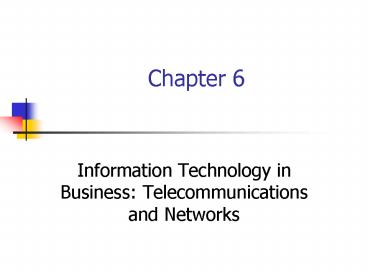Information Technology in Business: Telecommunications and Networks - PowerPoint PPT Presentation
1 / 36
Title:
Information Technology in Business: Telecommunications and Networks
Description:
High-frequency, short radio-frequency (RF) waves. Terrestrial microwave. Satellite microwave ... No office to foster new social ties and camaraderie. ... – PowerPoint PPT presentation
Number of Views:145
Avg rating:3.0/5.0
Title: Information Technology in Business: Telecommunications and Networks
1
Chapter 6
- Information Technology in Business
Telecommunications and Networks
2
Learning Objectives
- When you finish this chapter, you will
- Recognize why successful managers must be
familiar with telecommunications concepts and
terminology. - Know the principles of communication within a
computer system and among computers. - Be able to identify the major media and devices
that are used in telecommunications.
3
Learning Objectives
- Be able to list and explain the functions of
different network layouts and the concept of
protocols. - Understand how telecommunications can improve
operations in organizations. - Know the latest developments in
telecommunications media and transmission speeds.
4
Telecommunications in Business
- Telecommunications
- Transmittal of data from one computer to another
over a distance - Telecommunications has improved business in three
main ways - Better communication
- Higher efficiency
- Better distribution of data
5
What is Data Communications?
- Any transfer of data within a computer, between a
computer and another device, or between two
computers - Two Basic Modes
- Parallel transmission
- Serial transmission
6
Parallel/Serial Communication
7
Communication Direction
- Three Modes of Communication Between Devices
- Simplex
- One-way in one direction
- Half-Duplex
- One-way in two directions
- Full-Duplex
- Two-way in two directions
8
Communication Mode
- Asynchronous Communication
- In asynchronous transmission, the devices are not
synchronized by any timing aids. - Advantage of asynchronous transmission
- Does not need sophisticated and expensive timing
hardware - Disadvantage of asynchronous transmission
- Overhead, time spent transmitting bits that are
not a part of the primary data
9
Communication Modes
10
Communication Modes
- Synchronous Communication
- In synchronous communication, data are
transmitted using timing devices. - Messages are transmitted in packets.
- Advantage of synchronous communication
- Overhead in synchronous communication is
significantly smaller than in asynchronous
communication.
11
Communication Modes
12
Channels and Media
- Communication Channel
- Physical medium through which data can be
communicated. - Channel Capacity
- Narrow band
- Broadband
13
Channels and Media
14
Channels and Media
- Media
- A medium is any means by which data can be
transmitted. - Transmission speed
- A mediums capacity is determined by the range of
bits per second at which it can operate. - Baud
- Repeater
15
Channels and Media
16
Channels and Media
- Twisted Pair
- Telephone line made of a pair of copper wires
twisted to reduce electromagnetic interference
(EMI) - Coaxial Cable
- Commonly used for cable television transmission
- More expensive than twisted pair
- Greater transmission rate than twisted pair
- Much less susceptible to EMI
17
Channels and Media
- Microwaves
- High-frequency, short radio-frequency (RF) waves
- Terrestrial microwave
- Satellite microwave
- Optical Fiber
- Fiber-optic technology uses light instead of
electricity to transmit data.
18
Channels and Media
19
Modulation
- Analog vs. Digital
- Analog signals A continuous series of waves
- Digital signals A series of discrete bits
- Modulation Modification of a digital signal into
an analog signal - Demodulation Modification of an analog signal
into a digital signal
20
Modulation
- Amplitude Modulation (AM)
- Frequency Modulation (FM)
- Phase Modulation
21
Modulation
22
Modulation
- Modems
- Devices that modulate and demodulate signals
- Multiplexers
- Devices that allow several telephones or
computers to transmit data through a single line - Frequency division multiplexing
- Time-division multiplexing
23
Multiplexing
24
Frequency Devision
25
Networks
- LANs (Local Area Networks)
- Networks within a building, or within a group of
adjacent buildings - WANs (Wide Area Networks)
- Networks that cross organizational boundaries or
reach outside the company - Value-added networks (VANs)
- Wireless communication
26
Networks
- Network Topology
- Physical layout of the nodes in a network
- Star
- Ring
- Bus
- Tree
27
Network Topology
28
Protocols
- Communication protocols
- Rules governing the communication between
computers or between computers and other
computer-related devices - Network protocols
- Rules governing a network of devices
29
Protocols
30
Protocols
- LAN Protocols
- Polling
- Contention
- Token passing
- WAN Protocols
- OSI (Open Systems Interconnection)
- Standard protocol model
- Seven layers
31
Protocols
32
Switching Techniques and Transfer Modes
- Circuit Switching
- Message is communicated in its entirety from the
transmitting computer to the receiving computer - Packet Switching
- Message is divided into packets of bytes and
transmitted via several nodes
33
The Changing Business Environment
- Cellular Phones
- Teleconferencing
- Voice Mail
- Facsimile
34
Ethical and Societal IssuesTelecommuting Pros
- Saves travel cost and time.
- Decreases pollution.
- May reduce unemployment.
- Productivity higher among telecommuters.
35
ETHICS AND SOCIETYTelecommuting Cons
- Employers tend to pressure telecommuters to work
harder than workers in the office. - No office to foster new social ties and
camaraderie. - May negatively impact some segments of the
economy - Restaurants
- Downtown business and industries
36
- End of ChapterBack To Lecture Presentations

